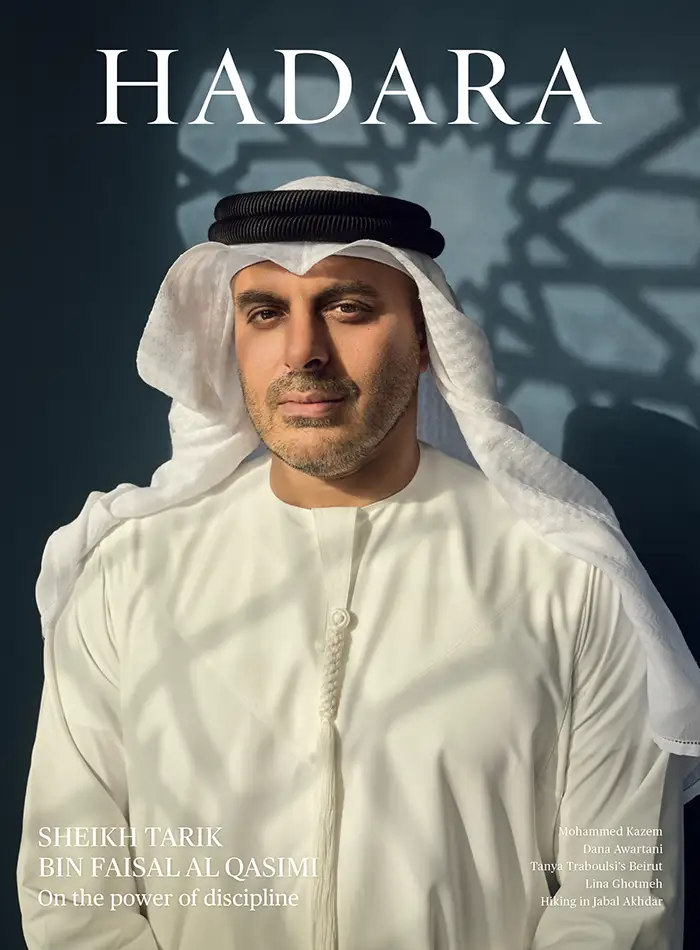Moments of transition
Sharjah Biennial 16 convenes under the theme “to carry”, and takes viewers on a journey from coast to coast.
By Anna Seaman
PHOTOGRAPHS BY ISMAIL NOOR
In her opening address at Sharjah Biennial 16, wearing a Palestinian keffiyeh and speaking with indisputable sincerity, Sheikha Hoor Al Qasimi spoke of the ever-greater need for solidarity. It is more than two decades since she took the helm of what is now the oldest biennial in the region, and which attracts a growing throng of international visitors. Throughout, Sheikha Hoor has remained consistent in her support of marginalised voices, a champion of diverse cultures and artistic integrity.
For SB16, she enlisted the experience of five female curators who collectively took a multidirectional approach resulting in a deeply conceptual, undulating trail of art and artistic presentations woven across Sharjah Art Foundation’s diverse venues.
“The biennial works examine the idea of impermanence and the notion of carrying our culture and heritage with us wherever we go,” Sheikha Hoor said. “They interrogate intergenerational relations, matrilineal legacies, and the importance of sites of convening and grieving. Finally, they imagine possible futures, from restructured social systems to new technological developments.”
With the participation of more than 200 artists and 650 works of art, the biennial is almost impossible to summarise, but its tone is captured in the open-ended title: to carry.
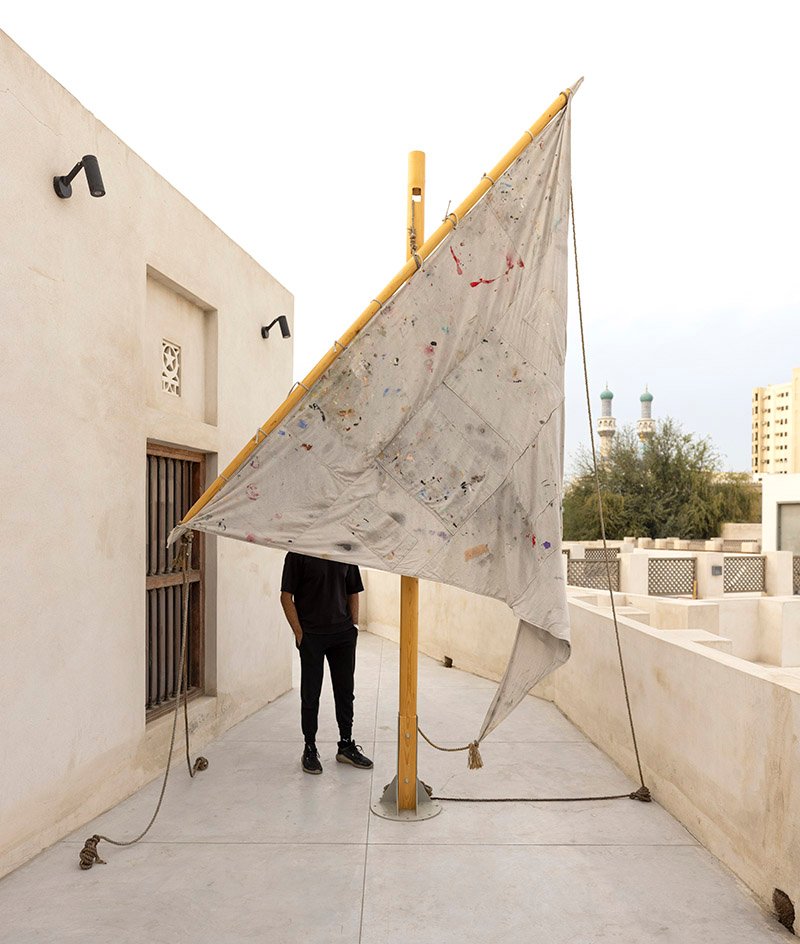
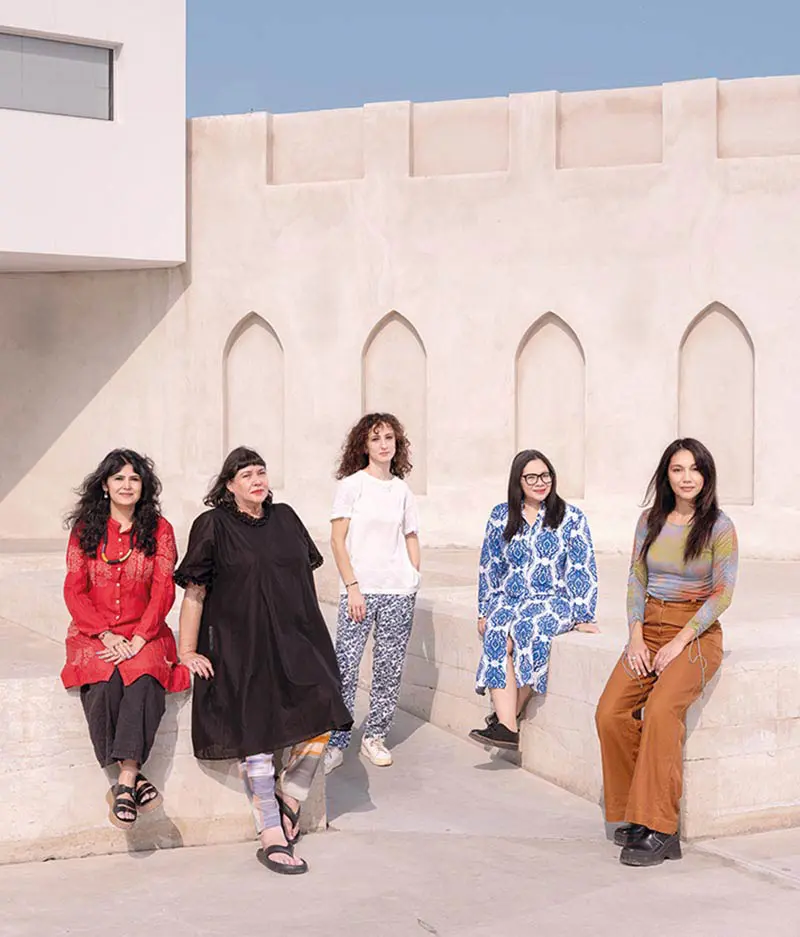
Header: Monira Al Qadiri, Gastromancer (2023). The oil industry has a significant impact on marine life. For example, the paint that protects oil tankers causes Murex molluscs to change gender. Gastromancer imagines thesefemale-to-male creatures as storytellers. Top: Why such a journey devoid of return (2021-2022) by Cassi Namoda turns a dhow sail into a gestural canvas that appears as a symbol of integrated oceanic memory and seafaring in the Swahili seas. Above: The five curators of SB16: Natasha Ginwala, Megan Tamati-Quennell, Zeynep Öz, Alia Swastika and Amal Khalaf. Curators photo by Danko Stjepanovic, courtesy of Sharjah Art Foundation.
“The biennial theme entails understanding our precarity within spaces that are not our own while staying responsive to these sites through the cultures we hold,” reads the curatorial statement, which proposes that the biennial offers pathways of “collective wayfinding” through “moments of transition”. While this alludes to the shifting of perspectives that impactful art can bring about, moments of transition are also experienced literally as a viewer traverses the biennial’s 17 sites. From the mangrove-cloaked shores by Kalba Ice Factory to the ghostly buried village at Al Madam, from a farm in the central oasis town of Al Dhaid to the port in Sharjah city, SB16 is a journey from coast to coast and during which almost countless stories can unfold.
Water is a protagonist. On the port side of Sharjah Art Foundation’s Al Mureijah district, an exhibition-cum-showroom hosted by SERAPIS MARITIME, a hybrid art, design and fashion entity based in Greece, contains public seating made from boat scraps and other marine industry materials and offers views of Sharjah’s shipyards. Inside the coral-walled neighbourhood, which is home to SAF’s six white-walled galleries, several more artworks pay tribute to maritime and coastal traditions. Monira Al Qadiri, whose practice often interrogates the ecological effects of oil extraction, presents Gastromancer (2023), two large fiberglass seashells suspended in a bath of red light. While Stephanie Comilang’s film Search for Life II (2025) explores themes of migration, labour, diaspora, and technology through the history of pearl diving, and is projected onto a screen fashioned from 500 strings of pearls.
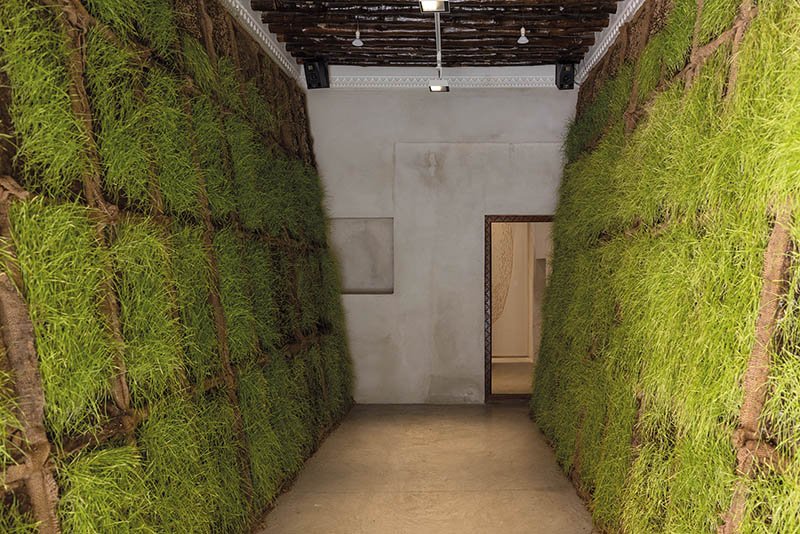
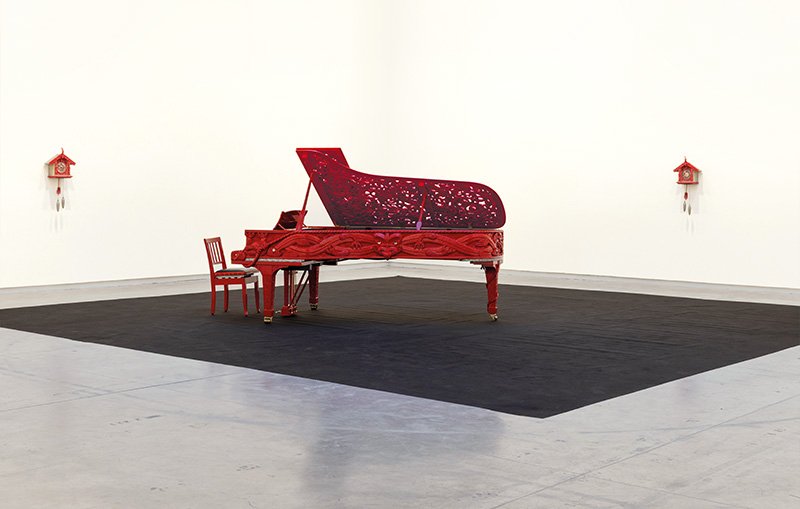
Top: Risham Syed’s installation Unn, Pani, Sut (Grain, Water, Truth) (2024) brings together agrarian, sonic and kinetic rhythms, centring the wheat field and granary as protagonists for exploring notions of generosity, sacred transfer and distribution in Sikh philosophy. Above: Michael Parekōwhai is a leading conceptual artist based in Aotearoa New Zealand. His work He Kōrero Pūrakau mo Te Awanui o Te Motu: Story of a New Zealand river (2011) is a Steinway concert grand piano that has been intricately carved with Māori motifs.
Despite its watery title, Michael Parekōwhai’s He Kōrero Pūra-kau mo Te Awanui o Te Motu: Story of a New Zealand river (2011) is a Steinway concert grand piano that has been intricately carved with Māori motifs. The title references a 1920 novel which explores colonialism and the transformation of identity. So, while not a literal river, this instrument, upon which any visitor can play, is a symbol of the passage of time and its music a reference to oral traditions, and the movement of people, histories, and stories. It also reflects the Māori understanding of rivers as living entities with spiritual and ancestral significance.
Sonic experiences are an integral part of the curatorial approach. There are visceral sounds, such as The Farm Project—a series of six sound installations made in response to co-curator Zeynep Öz’s YAZ Publications—which resonate through the otherwise barren atmosphere surrounding Al Dhaid’s Old Clinic and farmhouse. There are gentle sounds like the dripping of Risham Syed’s kinetic water well installation Unn, Pani, Sut (Grain, Water, Truth) (2024), and the billowing and snapping of Cassi Namoda’s dhow sail on the rooftop of Bait Habib Al Yousef, a metaphor for tales from Africa’s coastal traditions. There are also many performances throughout the biennial’s four-month run, a number of which rely on sound to narrate or to engage the viewer. Bilna’es, a record label and publishing platform for artistic communities in Palestine, played a DJ set during the opening weekend and, in the biennial’s Al Qasimiyah School venue, present a vinyl listening room.
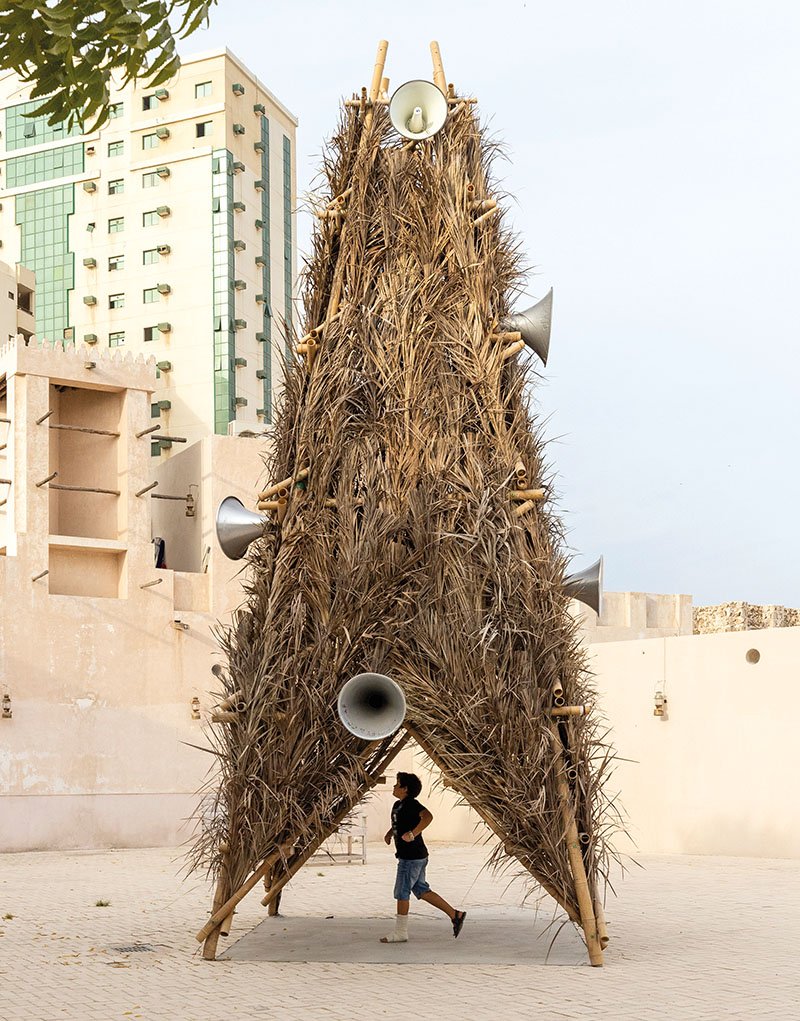
Artist, composer and educator Joe Namy explores the social and political forces that shape our understanding of organised sound. His installation Dub Plants (2024-2025) probes the historical kinship between radio culture and agriculture.
Sound is harnessed as a tool to link the disparate projects and locations over this vast, sprawling biennial. Joe Namy’s Dub Plants (2024-2025) is a makeshift radio tower crafted from bamboo with public-address speakers playing a soundscape composed from the movement of leaves in a frangipani tree on a farm in Al Dhaid. The installation explores the historically connected kinship between radio culture and agriculture. In Kalba Ice Factory, where Adelita Husni Bey’s commissioned film Like A Flood (2025) powerfully depicts the catastrophic results of Libya’s failing water infrastructure and is screened through a broken water-pipe installation in a darkened room, the sounds reverberate through your feet and add extra resonance to the pieces in the adjacent room, which tackle nuclear pollution and its devastating impact on nature and humanity.
With the five curators working on their own thematic presentations, which are often encountered as exhibitions within the wider exhibition, they worked hard over 18 months to distil their diverse curatorial approaches under the umbrella of a single question: What does it entail to carry a home, ancestors, and political formations with you? The derived title, then, becomes a vessel to hold the fluid content and context of this biennial.
“We do not intend to carry as a theme,” explains co-curator Alia Swastika. “It is more a gesture that connects our different approaches and interests. In to carry, we intend to offer a space for sharing and listening, resting and activating, reflecting and imagining.”
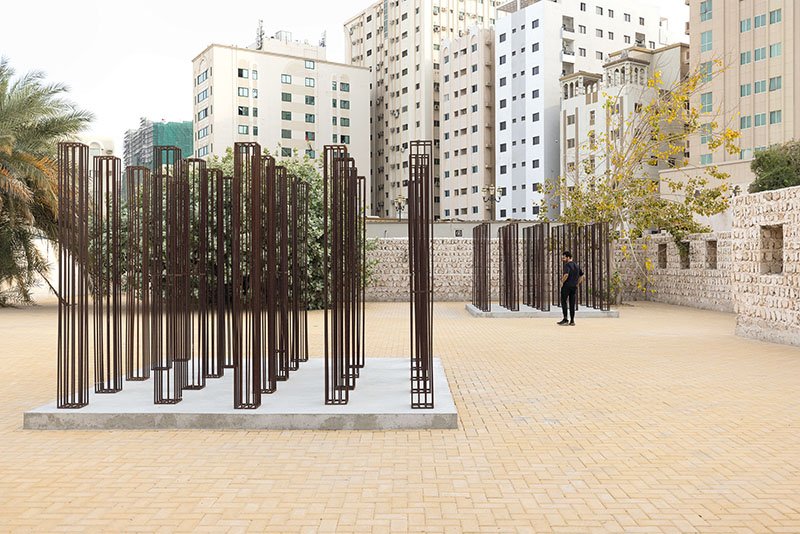
Kaili Chun is a sculptor and installation artist based in Hawaii. Her works address ideas of containment and exposure, agency and restraint.
It is this kind of reciprocity that seems to emanate from the biennial’s many parts. There is a rhythm to the curation which perhaps reflects what co-curator Megan Tamati-Quennell describes as a “sensibility” between the curators and shared respect for their individual projects.
There are also interesting moments of convergence, such as in Bait Al Serkal where Natasha Ginwala, Amal Khalaf and Alia Swastika focus on practices of weaving and textile making as collective pursuits and modes of storytelling. They look too into works that highlight songs, choreography, rituals of mourning, music traditions, myth making and indigenous relations to territory.
All five curators refer to their approach as being polyphonic, and the winding journey from coast to coast is certainly not linear. The beauty of this biennial is that it holds many chapters, verses, songs and sonnets, neither ordered nor chaotic. There is no definitive start, and equally one will never know if the experience has come to an end, nor what we carry with us after we leave.
“This biennial is at once an exhibition, exhibitions within an exhibition, an archive, a stage, a printing kiosk, a broadcast, a garment collection, an imprint, a farm, a song, a lament, an offering and a divination ritual,” says co-curator Amal Khalaf. To that list, we, as viewers, can only keep adding.




